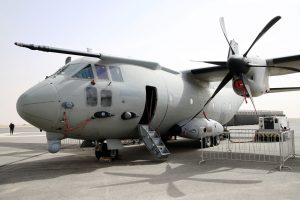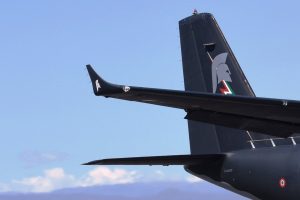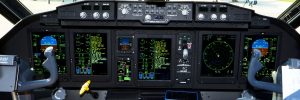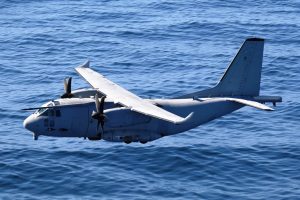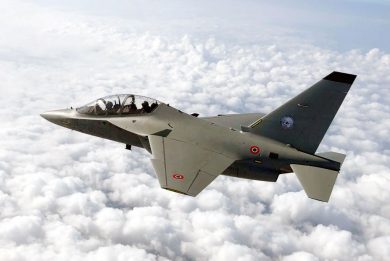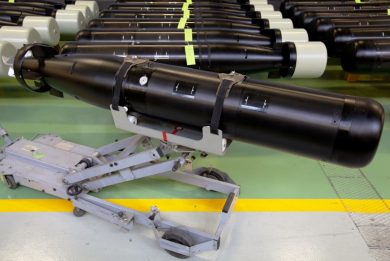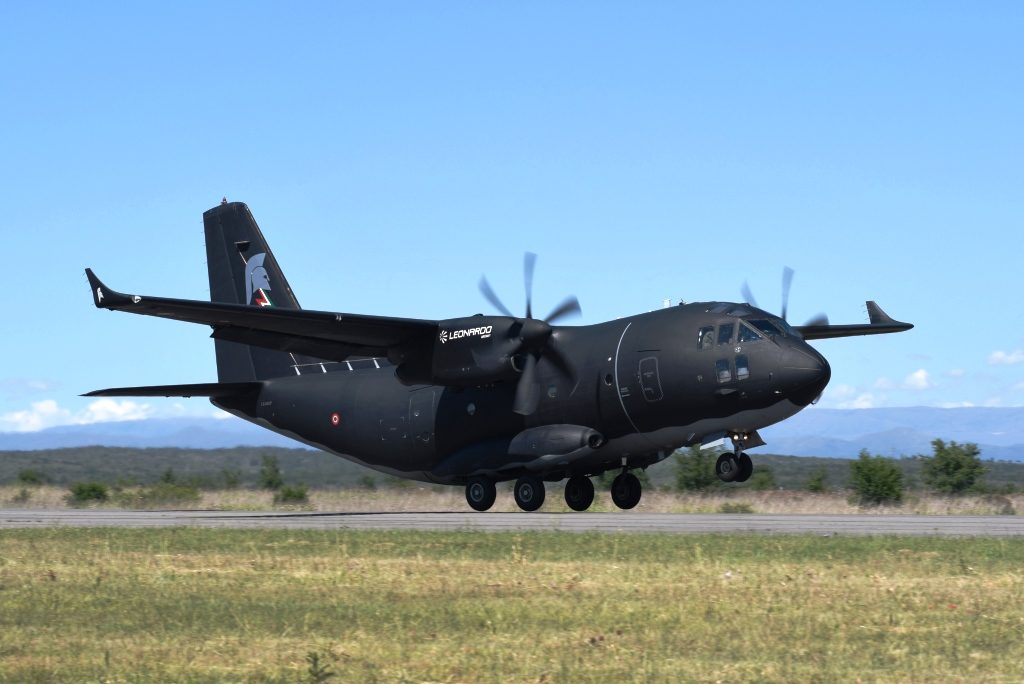
Leonardo promotes its C-27J Next Generation in the Middle East
Among the 15 known nations that employ or have ordered the C-27J, the sixteenth remains undisclosed, none is part of the Middle East. The presence of a C-27J on the apron of the World Defense Show premises was a clear sign that the Italian defence group intends to bag some new clients in that area, although the company rules are not to comment on marketing campaigns. Fitted with the ISR optronic sensor under the nose, the air refuelling probe, and the full defensive aids sub-systems suite, the Spartan was not yet at the Next Generation standard, this new configuration being discussed at length during a press briefing.
Multirole and flexibility are the two key words, Leonardo aiming at widening its marketing opportunities proposing the well known tactical transport aircraft in a series of new configurations, the capability to shift from one to the other being one of the key point of the Next Generation version.
This has however two major upgrades compared to the original version. “The first one comes from the new avionic suite, which is compliant with the new air traffic control regulations,” Christian Amendolagine, Senior Vice-President Military Airlifter and Special Mission Aircraft Line of Business, tells the audience.
“The other main improvement comes from the adoption of winglets, which increase performances especially in hot and high conditions.” this add-on having already been certified by the European Aviation Safety Agency (EASA), the adoption of winglets requiring a reinforcement of the wings; Leonardo exploited this redesign to ass three hard points in the outer wing section. Without modifying the powerplant the payload has been increased by 500 kg up to 11,600 kg (at normal 2.5 g, for tactical use at 3 g this is of 8,000 kg); however the major improvements came in hot and high conditions, where a significant increase in payload is obtained compared to that of the baseline aircraft, in the same operational and environmental conditions. Take-off and landing performances remain the same, respectively 580 and 340 meters at maximum take-off and normal landing weights at sea level.
These two major improvements are those that, according to Leonardo, will allow stepping towards a full multimission capable aircraft.
Detailing the work done on the avionics, Christian Amendolagine underlines that the new one adopted on the C-27J NG allows to easily integrate subsystems required by the customers, something that the previous configuration did not permit, as it was designed to host Leonardo-made systems. “Different radios, different waveforms, different navigation formats, will now be easily added by our integration laboratory in Italy, allowing to satisfy customers requirements,” he stated. The new cockpit is based on Leonardo solutions but includes elements coming from third parties, and while being designed to satisfy civilian airspace requirements, it includes FANS 1/A+ data link, TCAS 7.1, ILS Cat II and enhanced video TAWS, it is also meant to improve military ones, i.e. with the adoption of IFF Mode 5, while remaining of course compatible with night vision goggles use.
The capability to quickly load a mission kit on the plane to convert it for a required mission is the Leonardo answer to tactical multi-mission. “The Italian Air Force version of the aircraft visible on the apron has this capability, as it is equipped with a pallet-mounted mission system allowing the service to use the aircraft in its standard transport role, and when needed to transform it into a Command-Control-Communications Intelligence-Surveillance-Reconnaissance (C3/ISR) aircraft or into a Close Air Support (CAS) platform, i.e. to support Special Forces. This allows us to increase flexibility and reduce the aircraft life cycle cost,” Amendolagine explains. Pallet loading roll-on/roll-off is eased by the capability to raise the nose landing gear in order to lower the ramp close to the terrain.
The upgrades adopted on the C-27J NG make it also an ideal platform for fire fighting missions, Leonardo stresses; although this does not usually fall within air forces missions, nonetheless when nations are confronted to emergency situations, as it happened in recent times, the capability to re-role the Spartan for that mission might increase the overall nation capability to fight against massive fires. The company of course looks at this mission as the change to further widen its customer base in the non-military market.
Among the missions proposed for the C-27J NG, one is the VIP transport, for which Leonardo proposes specific modules that can be quickly installed, providing different levels of comfort plus a service module providing i.e. air conditioning, etc. “Many of our customers acquired those modules in order to be able to transport very high ranking dignitaries in remote areas in comfortable modules, installed on an aircraft featuring all self-defence systems to protect them from possible threats,” Christian Amendolagine tells the audience.
To make all aircraft able to accept any type of module, all of them are fitted-for the installation of elements such as the optronic ISR sensor at the front, specific antennas such as SATCOM, hard points to carry loads under the wings, which allows Leonardo to have a single production line maintaining the production flow without caring of the final use of the aircraft itself.
Among the most required mission kits the aforementioned C3/ISR and CAS are being developed for a number of customers, the Italian Air Force being one of them with the Praetorian programme.
“For us the reference configuration is the C3/ISR one, from which we are developing other ones,” Mr. Amendolagine says. Beside the electro-optic turret under the aircraft nose the C3/ISR configuration is fitted with a search radar and the AIS (Automatic Identification System) that allows tracking all vessels fitted with that system, those sensors providing full situational awareness. Currently Leonardo is working on the integration of the Seaspray 7500E V2 AESA radar by Leonardo UK, but for specific requirements the Osprey might also be selected to provide 360° coverage, avoiding the dead angle at the back caused by the fuselage with the Seaspray solution. On the right the first two pallets host three operator stations, the left side being dedicated to the rest area and the galley. A storage rack is installed on the left side, ordnance launchers being fitted in the ramp area. Observation seats are fitted on the third pallet beside the large panoramic windows ordnance; these were developed under a US Coast Guard requirement for search and rescue (SAR) missions. A SAR kit is available should the ISR aircraft be used for search and rescue missions, the kit being released from the rear ramp.
A typical CAS configuration maintains the electro-optical turret but will not be fitted with the radar and AIS. On the right the first two pallets host one more mission systems operators station, while the third pallet hosts the gun, which fires on the left side through a dedicated gun door; the GAU-23/A in 30×173 mm calibre was used for tests in the past years shooting from 8,000 to 15,000 ft altitude, Leonardo considering this calibre the one of choice. Precision-guided munition launchers will be installed in the ramp area, three per each side. The CAS aircraft is also able to act as radio-relay, allowing supporter troops on the ground to communicate with higher echelons exploiting the aircraft communication suite that includes a SATCOM.
“Our next step will be the antiship/antisubmarine configuration,” Amendolagine announces, “this ASuW/ASW role kit being forecasted in a few years time, once we will have fully finalised the C3/ISR one.” Leonardo aims at developing this new module using MOTS systems, not considering systems that are still under development and that might not fit the company roadmap. Compared to the C3/ISR configuration a magnetic anomaly detector and an electronic surveillance measure/electronic intelligence suite should be added. Operators’ consoles will be five, to cope with the increased amount of data to be processed on board, the ordnance rack is fitted on the left side of the third pallet, sonobuoy and ordnance launchers being installed in the ramp area. Overall the C-27J NG ASuW/ASW will be able to carry a weapons load of 3,400 kg (including sonobuoys) on the six hard points available in the NG version, maximum load for a single hard point being 650 kg. The hard points can be used to carry antiship missiles, antisubmarine torpedoes, but can also host external fuel tanks to increase the aircraft mission endurance. “We sill develop this configuration out of the current C3/ISR one, and we are already offering it to our potential customers,” Christian Amendolagine said.
The C-27J NG is already in service with an undisclosed customer, “and we will deliver to the next customer within year end,” Christian Amendolagine announced. The NG upgrades will also become available to existing operators who field the aircraft in its original configuration “Our vision is that in due time the whole fleet of C-27J will adopt the new avionic solution, and discussions are ongoing with the customers to identify the right time and the right way to carry out the upgrade, as this will impact the aircraft availability,” Leonardo Senior VP Military Airlifter and Special Mission Aircraft says. While the avionics upgrade is straightforward, strengthening the wing of existing aircraft to bring them to the NG standard is feasible, however cost-effectiveness should be studied case by case; in fact the company prototype was developed from an existing aircraft, however prototype is a case apart.
Photos courtesy Leonardo and P. Valpolini

